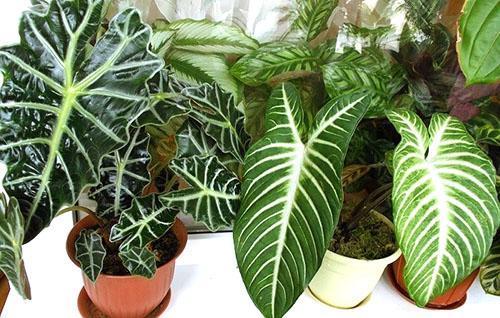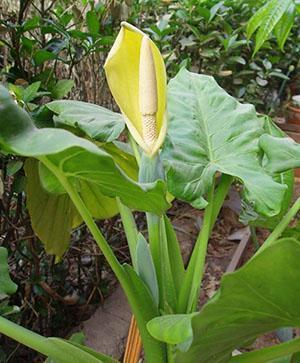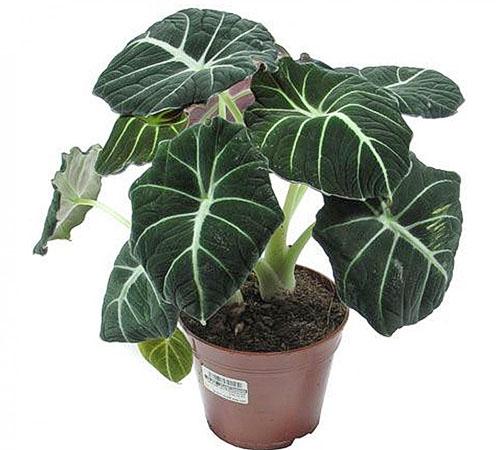We provide proper care for alocasia at home
 If there are many flowers in the apartment, and they are placed not only on the window sills, alocasia is chosen as an indispensable central link in the composition. It attracts with its harmony, imposing and beautiful sheets. Decorative alocasia at home with care that meets its biological needs. Native to the island tropics of Malaysia and the Philippines, it requires adequate living conditions. Look at the beautiful Calla flowers!
If there are many flowers in the apartment, and they are placed not only on the window sills, alocasia is chosen as an indispensable central link in the composition. It attracts with its harmony, imposing and beautiful sheets. Decorative alocasia at home with care that meets its biological needs. Native to the island tropics of Malaysia and the Philippines, it requires adequate living conditions. Look at the beautiful Calla flowers!
The main features of the plant

 The structure of the leaves is such that their dense surface sometimes looks artificial, made of leather. They have light streaks and in the dark they look creepy, like a skeleton. For the shape of the leaf, the plant is called elephant's ear. There are pores on the surface of the plate, called stomata, through which excess moisture evaporates. Plants can be 0.4 - 2 m in height.
The structure of the leaves is such that their dense surface sometimes looks artificial, made of leather. They have light streaks and in the dark they look creepy, like a skeleton. For the shape of the leaf, the plant is called elephant's ear. There are pores on the surface of the plate, called stomata, through which excess moisture evaporates. Plants can be 0.4 - 2 m in height.
Alocasia blooms in nature, releasing an ear on which berries and seeds ripen. It rarely blooms at home. By the way, there are few species that breed and live at home. The most famous are:
- alocasia polly;
- alocasia Amazonian;
- alocasia Sander.
 Reproduction is possible by leaf cuttings, suckers from roots, nodules, seeds and division of the rhizome.
Reproduction is possible by leaf cuttings, suckers from roots, nodules, seeds and division of the rhizome.
Alocasia care and reproduction
 This type of plant looks best in spacious rooms, in the bathroom, since there are the most suitable conditions for it. Another place for comfortable flower maintenance is a spacious kitchen. The only obstacle to keeping in the kitchen may be the lack of a draft-free zone. The slightest breath of cold air can destroy a beautiful flower.
This type of plant looks best in spacious rooms, in the bathroom, since there are the most suitable conditions for it. Another place for comfortable flower maintenance is a spacious kitchen. The only obstacle to keeping in the kitchen may be the lack of a draft-free zone. The slightest breath of cold air can destroy a beautiful flower.
Can alocasia be kept at home? Of course, you can, if you follow the requirements for caring for a home plant. Please note that this pet will need tall dishes, for example, glossy pots, made to match the leaves. To create moisture, you can use an aquarium in the composition or create a picturesque corner of expanded clay, sphagnum moss.
Lighting requirements
 Alocasia for home care needs bright diffused light without direct sunlight. This is usually the well-lit east and west side of the room. In winter, the plant must be moved to the lightest part of the house. When creating a composition in a dimly lit part of the house, you need to create artificial light flux.
Alocasia for home care needs bright diffused light without direct sunlight. This is usually the well-lit east and west side of the room. In winter, the plant must be moved to the lightest part of the house. When creating a composition in a dimly lit part of the house, you need to create artificial light flux.
Air humidity and room temperature requirement
The most demanding air humidity is Amazonian and weeping alocasia, optimally 80%. They are kept only in the kitchen. The rest of the domesticated plants tolerate some dryness, up to 50% in summer and up to 40% in winter. They create additional moisture using pallets with evaporating moisture, spraying with warm water and wiping the leaves with a wet cloth.But for all the exactingness to humid air, the roots should not bathe in water.
The temperature of the content should be 18 - 26 0, and in the summer from 21, and a little lower in winter.
Watering mode
 Alocasia is a moisture-loving flower, but it needs a systematic moderate watering without waterlogging. In this regard, it is unacceptable that there is stagnant water in the sump under the drain hole. At the same time, underfilling can lead to yellowing and shedding of leaves, which deprives the flower of its beauty. Therefore, in the summer they conduct moderate watering with warm, settled water every other day, and in winter they water it when the top layer of the earth dries up, about once a week. Simultaneously with watering and wiping the leaves with a damp sponge, you should pay attention to whether pests have settled on the bush.
Alocasia is a moisture-loving flower, but it needs a systematic moderate watering without waterlogging. In this regard, it is unacceptable that there is stagnant water in the sump under the drain hole. At the same time, underfilling can lead to yellowing and shedding of leaves, which deprives the flower of its beauty. Therefore, in the summer they conduct moderate watering with warm, settled water every other day, and in winter they water it when the top layer of the earth dries up, about once a week. Simultaneously with watering and wiping the leaves with a damp sponge, you should pay attention to whether pests have settled on the bush.
You should never use polishes to make alocasia leaves shine. This will lead to the death of the leaf. A healthy leaf blade is decorative anyway.
Soil, fertilization, feeding
 Alocasia requires an acidic soil with a pH of 5.5 - 6.3. Such a composition is created on the basis of low-lying peat and forest humus taken immediately under the litter. A handful of needles added to the substrate will help create the desired acidity. On this basis, after steaming and disinfecting, the desired mixture is created in different proportions. It is proposed, as an option, this:
Alocasia requires an acidic soil with a pH of 5.5 - 6.3. Such a composition is created on the basis of low-lying peat and forest humus taken immediately under the litter. A handful of needles added to the substrate will help create the desired acidity. On this basis, after steaming and disinfecting, the desired mixture is created in different proportions. It is proposed, as an option, this:
- peat lowland - 2 hours;
- leaf humus - 6 hours;
- sand - 1 tsp;
- sphagnum moss - 2 hours:
- crushed charcoal - 3 tsp
Specialists in the cultivation of alocasia advise to pour a tablespoon of complex fertilizer on the bottom of the container immediately onto the expanded clay layer and sprinkle it with a substrate. This will allow you not to worry about feeding for a year after plant transplantation. They consider this way of feeding alocasia during care and reproduction more acceptable.
 If the soil is not filled with fertilizer, then systematic fertilizing irrigation is required. In spring and summer, during intensive growth, once every three weeks, you need to nourish the plant nitrogen components. Potassium salts are also required. In the complex, it is potash nitrate, but it is better to take specialized liquid dressings for home flowers. For example, "Agricola" for ornamental plants diluted with a teaspoon per 3 liters of water. In winter, fertilizing watering is done twice less often. For young plants, phosphorus is important, which must be given in soluble salts. They contribute to the rapid development and strengthening of the root system.
If the soil is not filled with fertilizer, then systematic fertilizing irrigation is required. In spring and summer, during intensive growth, once every three weeks, you need to nourish the plant nitrogen components. Potassium salts are also required. In the complex, it is potash nitrate, but it is better to take specialized liquid dressings for home flowers. For example, "Agricola" for ornamental plants diluted with a teaspoon per 3 liters of water. In winter, fertilizing watering is done twice less often. For young plants, phosphorus is important, which must be given in soluble salts. They contribute to the rapid development and strengthening of the root system.
The choice of dishes is also important. The peculiarities of alocasia require the root to grow deeply, and when planting, the roots are directed vertically. Therefore, tall, narrow vessels with good drainage are chosen. The new container should be 3 cm larger than the old one.
Transplant, breeding alocasia
 For adult plants, a transplant is needed every 2-3 years, as the soil is compacted and depleted in nutrients. The transplant is carried out in early spring, when the plant is just beginning to develop. If the plant is healthy and has been transplanted recently, it is best to do a transhipment. That is, the plant is carefully removed from the old dishes and settled on a layer of drainage and sprinkled substrate, neatly with a lump of earth. Since the pot is larger, soil is poured, but it is not compacted mechanically, but only slightly shaken. The plant dropped into the vessel is watered, the earth settles, it is poured up to the neck and the transplant is completed.
For adult plants, a transplant is needed every 2-3 years, as the soil is compacted and depleted in nutrients. The transplant is carried out in early spring, when the plant is just beginning to develop. If the plant is healthy and has been transplanted recently, it is best to do a transhipment. That is, the plant is carefully removed from the old dishes and settled on a layer of drainage and sprinkled substrate, neatly with a lump of earth. Since the pot is larger, soil is poured, but it is not compacted mechanically, but only slightly shaken. The plant dropped into the vessel is watered, the earth settles, it is poured up to the neck and the transplant is completed.
All parts of the plant on the cuts secrete poisonous juice. Therefore, when working with a transplant, you need to observe protective measures - work with gloves. For the same reason, animals should not be allowed to gnaw the flower.
In other cases, the plant is completely washed from the old soil and dried in a horizontal position with straightened roots. At the same time, the children are chosen, the bushes are taken apart and each is planted in a separate container.
Other breeding methods are carried out:
- leaves;
- seeds;
- stem buds;
- segments of rhizomes.
In order for the plant to completely repeat the shape of the mother bush, the bud is taken on the trunk, cut out with pulp, and rooted in the substrate under the hood in the warmth. The resulting wound on the trunk is treated with crushed coal.
 Propagation by cuttings obtained from the upper part of the shoot gives 100% survival rate. The handle is cut under 45 0, treated with "Kornevin" or other biological product and placed in warm soil, controlling its moisture content.
Propagation by cuttings obtained from the upper part of the shoot gives 100% survival rate. The handle is cut under 45 0, treated with "Kornevin" or other biological product and placed in warm soil, controlling its moisture content.
The plant propagates by seeds only fresh. They are immediately sown in warm soil, the earth is kept moist, sprinkled from above. Seeds sprout unevenly, from several days to three weeks. Transplant seedlings when they create a good root system.
 Rhizomes disassembled for transplantation must have either a finished plant with leaves, or a growth bud. They are also rooted in the substrate after the wounds of the separated roots have dried. Rooting is carried out only in warm, moist soil.
Rhizomes disassembled for transplantation must have either a finished plant with leaves, or a growth bud. They are also rooted in the substrate after the wounds of the separated roots have dried. Rooting is carried out only in warm, moist soil.